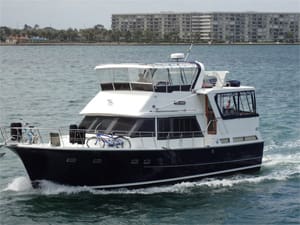When you have a mess to clean up, sometimes the best solution is to take matters into your own hands and suck it up. On an offshore trawler, this can mean a lot of different things, but for this discussion the focus is on using onboard suction devices to remove, collect and/or transfer excess liquids, dirt, fur, etc. Cleaning up to keep your trawler uncluttered and ship-shape requires constant attention, and a common tool that can be employed in a variety of useful purposes is a simple vacuum unit.
At the Merrill family dinner table while growing up, my father would challenge us to spell two amusing words. One was “syzygy” (a great boat name and one definition is the alignment of three or more celestial bodies) and the other word was “vacuum” (my mom struggled with this one because there was no Q, the double U’s are not a W and it doesn’t end in u-m-e). I’ve grown up thinking about vacuum as an unusually spelled word, not an essential tool, but it is certainly both.
A good vacuum is one of many versatile appliances you should consider having on board, and there are several different sizes and applications that you may find relevant to dial-in your trawler. There are plug-in types (if you have an AC inverter) and battery types, which often don’t create a lot of pressure.
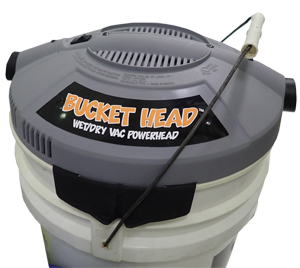 |
|
The Bucket Head brand is a vacuum unit that attaches atop most five-gallon buckets. |
For many trawler owners, having a wet vac designed to work with liquids is truly an essential piece of kit. You can use these wet vacs to soak up spills, clear out potty water in a fouled toilet (don’t worry, this won’t happen to you) and also clean out bilges. Dealing with the offending liquids and proper disposal is one concern, and if you are working with “nasties” I suggest you plan ahead by wearing nitrile gloves to protect your hands. Depending upon the product model you have, you may need to remove the filter before going after fluids. After use, dry out your filter before re-inserting to prevent mildew.
If you do remove “unsanitary” fluids from your bilges or heads, you may want to relegate that vacuum unit to “black water” projects and use a “clean water” vacuum for spilled drinks or refrigerator items that fall on the galley floor.
Due to fire potential, DO NOT use a wet/dry vacuum to remove diesel, paint, thinners or any oil-based petroleum products. A proper siphon, long enough (10 feet) to reach and transfer flammable liquids to a large plastic container for collection is a great vacuum-esque tool to carry. This is a store-bought gasoline siphon with a self-priming brass end and heavy walled hose (0.5- to 1-inch diameter). The self-priming siphons do not involve electricity or lung power to work. In a pinch, depending upon priorities, you can scavenge the squeeze bulb hose from your outboard fuel tank if you have one.
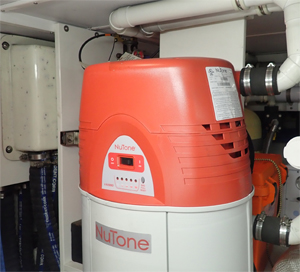 |
|
Many larger trawlers are outfitted with central vacs and long-reach hoses. Using a common broom, debris is swept to a wide rectangular dustpan-like opening, which then sucks it to a central storage canister. |
An obvious word of warning: Please be extremely careful using a plugged-in electric vacuum around water so you don’t get electrocuted!
Many vacuums come with an assortment of attachments, and I’ve even used the wand extension to reach something that was beyond my grasp — in which case I then had to make sure to look for the retrieved item in the filter or bottom of the catch basin once I grabbed my target.
Some larger shop vacuums are not designed to handle liquids; they are dry only and not as practical to have on your trawler. Purchase a large wet/dry vacuum that can handle two to three gallons of liquids. Like anything you purchase for a boat, it is worth doing a little investigating to find products that will last longer. Also make sure to search for versatile tools, as space is limited on a trawler. Many trawler owners use the Bucket Head brand — a vacuum unit that attaches atop most five-gallon buckets.
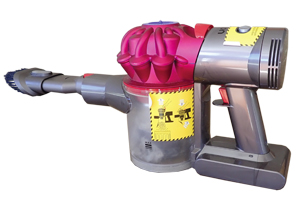 |
|
Small, hand-held and cordless “dustbusters” can be used for various purposes, including getting rid of bugs. |
Most large bucket-type shop/wet vacuums have two directions of airflow: one that is used for “inhaling” and the other for “exhaling.” To clear marina tree leaves off the deck, I’ve reversed the airflow to scatter the leaves. I’ve also used the push/exhale side of the wet vac airflow to blow out something that is stuck in a hose and to dislodge a clogged intake through-hull fitting. Again, common sense suggests that when you are working with an underwater fitting like a through-hull valve while you are afloat, it’s best to have a helper and to quickly close the valve once it has been cleared.
Many larger trawlers are now arriving outfitted with central vacs and long-reach hoses. One of the cool newer features is a sweeper opening on hard floor surfaces like galleys. Using a common broom, you sweep debris to a wide rectangular dustpan-type opening, which whisks it away to the central storage canister. There are usually several strategically convenient suction ports to plug your long hose into.
The Swiffer Sweep + Vac tools are glorified brooms that scrub, mop and have a suction component to help lift dirt, crumbs and other particle debris up off your wooden soles for more efficient tidying up. These, like flat-screen TVs, seem to be designed specifically for boats.
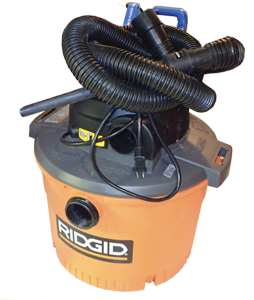 |
|
A wet/dry vac for big projects is one of four useful onboard vacuums recommended. |
One of the best and most creative uses I’ve ever seen for a vacuum on board is using one of the small, hand-held, cordless (battery-operated) “dustbusters” for debugging. Let me explain. I was crewing on a Nordhavn 62 delivery and we had to pull into safe harbor to wait for a new part. We had been running for several hours and the interior of the boat was warm. Once anchored and settled, we opened up the doors and windows to let the sea breeze come in and cool us off. Before we knew it, we were inundated with kelp flies. We quickly closed up all of their points of entry to stop the invasion, but that also sealed the fate of those that remained, effectively signing them up as stowaway passengers on our ship. Now what? We then spent the rest of the trip trying to get rid of them. We realized that the flies tended to end up dancing around our pilothouse windows looking for escape.
That’s when we put our trusty hand-held portable vacuum to task “fetching” them when they were in range. Our ship’s log for that trip was modified. In addition to the traditional recordings of latitude, longitude, heading, speed and all the other relevant hourly log details, we added a new column to list how many kelp flies the helmsman was able to catch during each hour on watch.
There are several useful onboard purposes for vacuums as described above, and this is only a start. I encourage you to consider acquiring at least four: a wet/dry for big projects, a portable handheld for small projects, a long broom/mop-type for wood floors and a common household upright vacuum for carpeted areas. I’m not aware of a Swiss-Army-knife, do-it-all vacuum that can handle all of the projects you need, so it’s advisable to check out product reviews and determine which models offer you the most versatility.
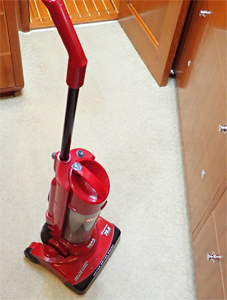 |
|
A common household upright vacuum is useful for carpeted areas. |
Without endorsing any specific brands or models, I’ve heard good things regarding reliability of those brands previously mentioned and good performance reviews about Shop-Vac, Dyson, Shark and others. Now when you have a mess to contend with, hopefully you can smile and shrug it off with confidence knowing you have what it takes to suck it up!
Jeff Merrill, CPYB, is the president of Jeff Merrill Yacht Sales, Inc.- www.JMYS.com. He is a veteran yacht broker who provides individual attention and worldwide professional representation to buyers and sellers of premium brand, oceangoing trawlers. Merrill is active in the cruising community as a public speaker and writer and enjoys spending time at sea with clients. Jeff has written several articles for Ocean Navigator’s Power Voyaging column and is constantly looking for new ideas to improve and simplify the trawler lifestyle. If you have a suggestion or want to get in touch, please email Merrill at Jeff@JMYS.com.

